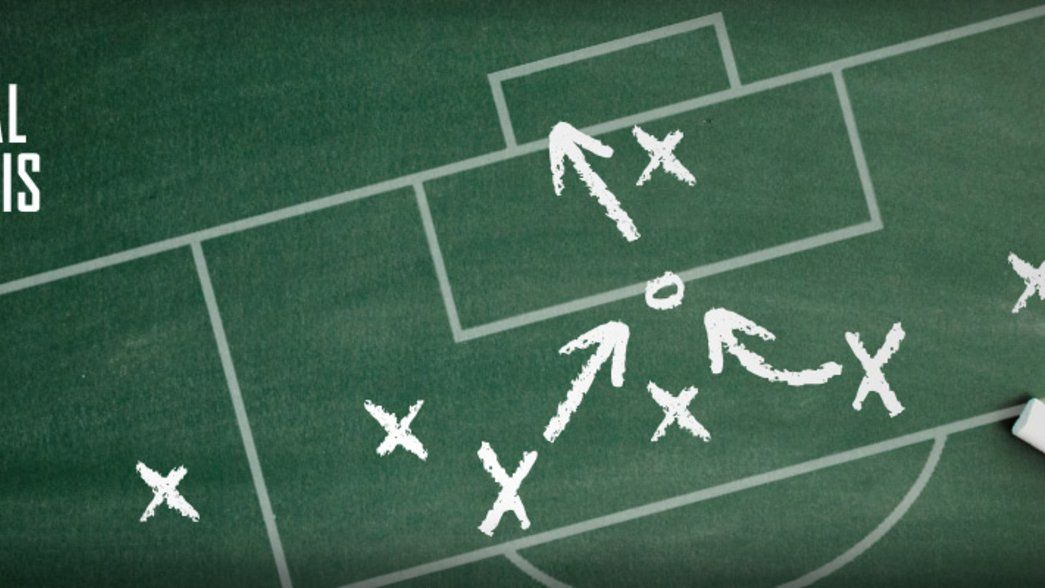Our 2012/13 season review continues here with a tactical reflection on Arsenal's campaign.
1 Different options up front
The signing of Olivier Giroud provided Arsenal with a classic central striker who holds the ball up reliably, and thrives on crosses. Although the Frenchman established himself as a regular starter, Arsene Wenger had options up front, and and in 14 of the 38 league games, Arsenal used a completely different type of centre forward: either Gervinho, Theo Walcott or Lukas Podolski.
"In 14 of the 38 league games, Arsenal used a completely different type of centre forward"
That meant Arsenal had a range of tactical options. This was particularly obvious at the beginning of the campaign, while Giroud was still finding his feet in English football. In the 6-1 thrashing of Southampton, for example, Arsenal were up against a defence that plays high up the pitch, so Gervinho started because of his pace and dribbling ability. A few weeks later, against a Fulham side that defends deep, a penalty-box prowler was required, so Giroud played.
Just as Gervinho scored twice against Southampton, Giroud scored twice against Fulham - and although no Arsenal player reached 15 league goals, the attackers shared the goalscoring burden nicely.

Fig 1
2 Arteta’s consistency in a new role
Having excelled slightly higher up the pitch last season, Mikel Arteta was forced to embrace a new, deeper position in 2012/13. “It’s more about the first pass and finding guys like Santi [Cazorla] or Abou [Diaby] in good positions, areas where they can make their quality count, rather than trying to play the final ball,” he said.
For the second consecutive season, Arteta has played more passes per game than any other Premier League midfielder, and his completion rate has risen slightly from 90.8% to 91.5%. But more impressive has been the way he’s become a reliable defensive presence - last season he made 4.4 tackles and interceptions a game, this season it was 6.1.
Across Arteta’s 34 Premier League starts this season, he’s played alongside a variety of partners. Abou Diaby started the season strongly, Jack Wilshere took over midway through, before Aaron Ramsey had a crucial impact during the run-in. “No two of us are the same in terms of technique or physique, and we offer different things,” says Arteta. Amid flexibility in more advanced positions, Arteta has been the solid, reliable metronome.

Fig 2
3 Koscielny and Mertesacker’s partnership
After Arsenal’s 2-1 defeat at White Hart Lane in March, many suggested Arsenal’s chances of finishing above Tottenham and reaching the Champions League once again were slim. Instead, Arsenal rallied in their final 10 matches, recording eight victories and two draws.
"They formed a tremendous relationship because they complement each other's qualities perfectly"
From those 10 games, Arsenal kept clean sheets in five, and conceded only a single goal in the other five - and the centre-back partnership of Per Mertesacker and Laurent Koscielny deserve great praise. They formed a tremendous relationship because they complement each other's qualities perfectly: Mertesacker is tall, strong and consistently wins aerial duels, while Koscielny is quicker, more mobile and anticipates danger more keenly. Mertesacker excels in the penalty box, Koscielny often works higher up the pitch.
Arsenal weren’t spectacular in the final weeks of the campaign, but they recorded three consecutive 1-0 away victories to seal Champions League football. With Mertesacker grabbing the only goal at Fulham and Koscielny doing the same against Newcastle, it was only right that Arsenal’s centre backs had their share of the limelight.

Fig 3
4 Cazorla’s versatility
There are three 'rules' for top-class Spanish playmakers. You must be small, you must be an excellent short passer, and you must be highly versatile. Santi Cazorla ticks all three boxes and, in a fantastic debut Premier League season where he started 37 matches and appeared as a substitute in the other, his flexibility was particularly useful.
For the first half of the season, Cazorla played as the central playmaker, connecting midfield and attack but also drifting to the flanks. “It’s a position I really like, not one I’ve played in much in recent years, but I will play there without problems,” he said. He made an instant impact as Arsenal’s best player on his debut against Sunderland, and managed a goal and assist in Arsenal’s first win of the campaign, at Anfield.
In 2013, however, he’s played more regularly on the flank. “He seems to be comfortable when he plays off the left”, says his compatriot Arteta. “He’s got a lot of freedom and he causes problems to the other teams because we can use the extra man in midfield.” That has given Arsenal balance, with Cazorla drifting inside from the left, and Walcott sprinting in behind from the right. From either a central role or drifting inside from the flank, Cazorla’s passing quality is obvious.

Fig 4
5 Differing levels of pressing
Arsenal’s approach without the ball has varied. Sometimes there’s been pressing high up the pitch, on other occasions Arsenal have retreated into a deep shape before counter-attacking. This means Arsenal can be flexible to compete with different opponents appropriately.
"Recently Arsenal have pressed higher up the pitch, partly thanks to the re-emergence of Tomas Rosicky"
In the first victory of the season, over Liverpool, Arsenal sat deep in two banks of four before springing forward ruthlessly on the break. The defence and midfield stayed compact, and won possession close to Arsenal’s own box.
Yet recently Arsenal have pressed higher up the pitch, partly thanks to the re-emergence of Tomas Rosicky at the top of the midfield triangle. “If I’m the highest one of the three midfielders, it means I’m the first to start the pressure,” he said. “When we lose the ball, we begin pressing immediately. The three seconds afterwards are vital and I think we are all aware of that - when the opposition get possession, we’re after them immediately.”
The energetic tackling at the start of the 1-1 draw against Manchester United was a good demonstration of that battling quality.

Fig 6
Copyright 2025 The Arsenal Football Club Limited. Permission to use quotations from this article is granted subject to appropriate credit being given to www.arsenal.com as the source.




